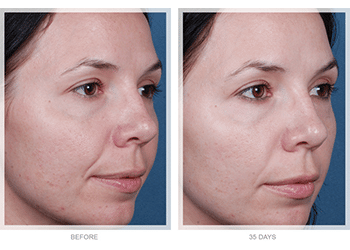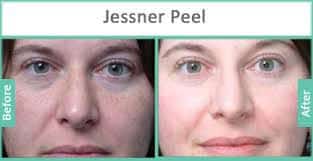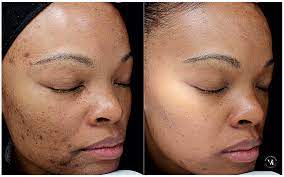About Chemical Peel
Chemical peels have been gaining popularity in recent years as skin resurfacing treatments, but they’ve been used as beauty treatments since the time of ancient Egypt.
Skin is the largest organ of the human body and is composed of multiple skin layers responsible for its health and function. Each layer has a specific function and contributes to the overall visible appearance of the skin. Chemical peels are a safe and effective treatment regimen designed to rejuvenate skin layers and improve its appearance and health. $300-$400
Jessner Peels
The Jessner peel falls somewhere in the middle. “The Jessner solution is a commonly used medium-depth peeling agent, which means the solution only affects the upper layer of the dermis, in a controlled manner.
The Jessner peel is done by brushing an acidic liquid onto the skin to remove the top layers and encourage new, younger looking skin to grow.
The Jessner peel was first formulated over a hundred years ago, and it’s still in use today thanks to its ability to:
- reduce dark patches and age spots
- even out skin tone
- reduce the appearance of scars
- smooth fine lines and wrinkles
- treat melasma (skin discoloration), hyperpigmentation, and acne scars
While many chemical peels can cause lasting discoloration on darker skin, a recent small study found that a modified Jessner’s solution safely and effectively reduces melasma and pigment imperfections in darker skin.
Tca Peels
What are TCA peels?
TCA is a non-toxic chemical (trichloracetic acid), which has been used to perform skin peels for over 20 years. It is a relative of vinegar (acetic acid.) When TCA is applied to the skin, it causes the top layers of cells to dry up and peel off over a period of several days to one week. When the old skin is peeled off, it exposes a new layer of undamaged skin, which has a smoother texture and more even color.
Some dermatologists, in fact, still prefer TCA peels for treating sun damage or melasma, usually in combination with prescription creams. TCA peels are safe in the hands of an experienced dermatologist. TCA peels may be a good option, particularly if you have melasma because many lasers are difficult to use when treating melasma.
TCA peels are most commonly used:
- to reduce brown spots and age spots
- to improve the texture of leathery, sun damaged skin and impart more glow
- to improve melasma
- to treat some types of acne
- to reduce fine lines
How do TCA peels work and what are the different depth peels?
All peels work by removing a layer of sun damaged skin. Superficial or “light” peels remove only the top layer, mostly the layer of dead skin called the stratum corneum. Progressing from medium to deep peels, the layer of skin removed is greater with each increase in strength of the peel solution. The stronger the peel solution the greater the risk of complications like uneven pigment or even scarring.
TCA Peels are 15%-30%
TCA peels can be done at different depths from shallow to deep. Most dermatologists now are using laser technology instead of deep TCA peels, but light to medium depth peels are still in widespread use.
Lighter TCA peels are usually done in a series of 2 or 3 for best results. This is similar to other light peels that usually involve hydroxy acids such as glycolic, salicylic, or a mixture of other hydroxy acids. Medium depth TCA peels are usually done once or twice a year and do require some downtime – usually about a week – when the peeling is obvious.
Before & After



*Individual Results May Vary*
Frequently Asked Questions
To achieve optimal results following a chemical peel treatment, it’s important to find a professional that
you trust. Comprehensive skin evaluation with correct diagnosis is the key to success. Once your skin has
been identified to be of a particular type and correct diagnosis was established, the next step is to begin
designing a chemical peel that will solve the problem.
“Pre-treatment” regimen prior to the actual peel is designed to prepare the skin for a rejuvenation
treatment in order to yield the best possible results and decrease the downtime.
- Helps reduce visible signs of sun damage, including fine lines and wrinkles.
- Improves the appearance of uneven skin tone and dullness by exfoliating surface cells.
- Softens and soothes the skin’s surface texture.
- Decreases the frequency of acne breakouts and fades the appearance of post-acne discoloration.
The office has many different types of peels to cater to all skin types. They range from mild to severe
and can be hydrating to cater to dry skin or drying catering to oily skin.
- Gel Peel
- Micropeel
- Micropeel Plus
- Advanced Corrective peel
Chemical peel does not always result in the skin peeling. Peeling is considered a side effect of the
treatment rather than a mark of its effectiveness. If you don’t peel after your treatment, please be
assured that that is an absolutely normal response.
Each peel is designed to target specific treatment area in a specific skin layer.
In general, the stronger the peel, the deeper it penetrates the skin, therefore, the recovery time will be
a little longer.
AP carries a full line of professional chemical peels to address multiple skin problems. Please call for
your consultation today.
The answer depends on the diagnosis and the desired effect. In general, 3-6 treatments spaced 4 weeks
apart are recommended to restore the skin texture. The exact answer will be provided at the time of
your consultation with our doctors.
The answer largely depends on the type of the chemical peel performed. Some mild peels will have
transient redness which will resolve in 24 hours, where others might have redness and peeling 1-2
weeks after the treatment.
*Results and duration of effect may vary; no guarantee of specific results can be given.